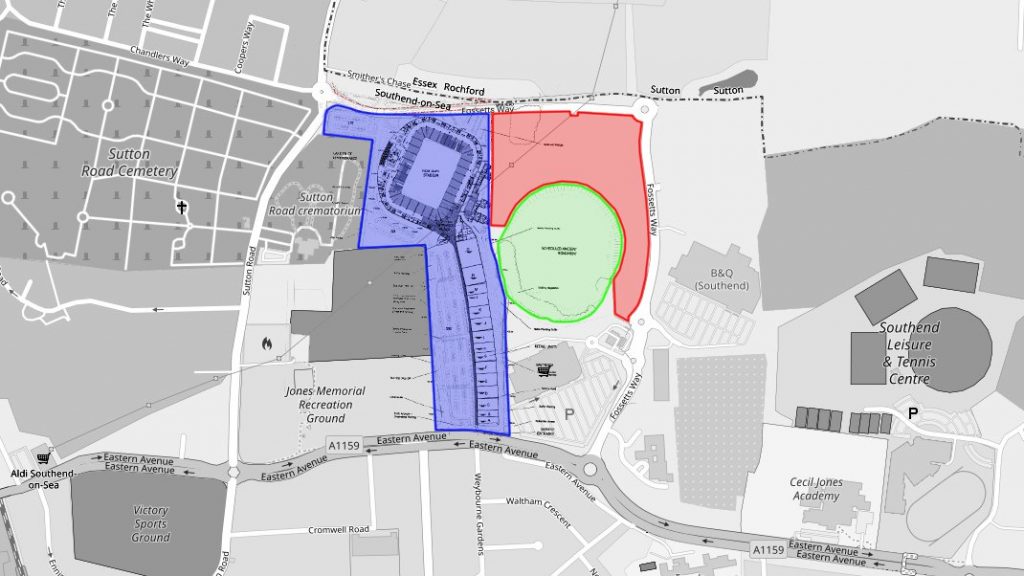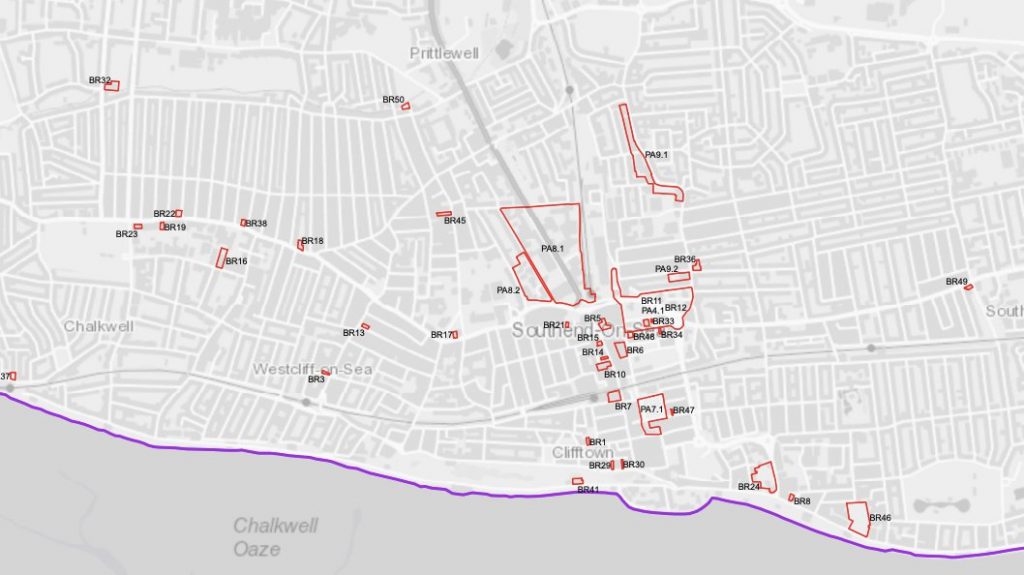In the past few weeks, a new offshoot of the #SaveSouthendNHS campaign has been launched demanding that Southend Council build 400 new ‘affordable’, private rent, and social homes on the former NHS-owned land adjacent to the proposed Fossetts Farm developments.

The campaign, dubbed Fossetts for The People says that “this is a great opportunity for Southend Council to take positive steps towards alleviating the housing crisis we face in this town by building homes to let at truly affordable rents to people that are most in need in Southend.”
Also adding that “the alternative will be that a private developer moves in, creating hefty profits for itself and its shareholders by building ‘executive’ homes for London commuters.”
‘Fossetts For The People’ reached out to the South East Essex Green Party and asked us to join their campaign.
The 14-acre site behind Waitrose on Eastern Avenue was previously owned by the NHS and was due to be the site of a new diagnostic and treatment centre. Earlier this year, the land was sold by the NHS to the Government Agency Homes England for £7.8 million.
The area including neighbouring land to the east and west, (which in 1994 was classified as Green Belt and as “land of high agricultural quality”) was reclassified as ‘safeguarded land’ following a legal challenge by a private developer.
The National Planning Policy Framework 2012 advises that local plans should make clear that the safeguarded land is not allocated for development and that planning permission for the permanent development of safeguarded land should only be granted following a Local Plan review which proposes the development.
To date, the proposed Southend United FC Stadium or this housing estate is yet to be included in the Southend Local Plan.
Rather notoriously, Rochford District Council remains openly opposed to the Stadium proposals, citing;
- The height, mass and bulk of the proposal would have an adverse impact upon the openness of the countryside and the Green Belt.
- The increase in activity as a result of this use would be likely to have an adverse impact upon the local highway network.
- The application is not supported by a Green Travel Plan and given the site’s location, remote from a range of other forms of transport, then there will be a heavy reliance upon the use of private motor vehicles, which would be contrary to the principles relating to sustainable development.
The site Fossetts For The People are campaigning for, also has to contend with a Scheduled Monument immediately abutting the southern boundary of the site known as “Prittlewell Camp.”
The planning application for an NHS Diagnostic and Treatment Centre in 2003 was accompanied by a Desk Based Archaeological Assessment and Archaeological Evaluation Report based on 43 archaeological trenches across the subject site.
Studies found Post-Medieval deposits, early deposits including some worked flints, flint flakes, bone and pottery fragments and a possible hollow way which may have led to the entrance to the camp. Evidence of a large municipal dump was also found on the western part of the site.
Any housing planned for the site would also likely be quite-rightly subject to similar archaeological scrutiny.
OUR OPINION:
1. The new SUFC Stadium and its Retail Park will kill off our already-struggling High Street.
Most planning applications are granted or rejected on a precedential basis; especially big ones.
If one house is granted a one-storey extension, you can almost guarantee that any neighbouring house will also be granted planning permission based on the precedent that has been set.
Building a 400-home residential estate on adjoining agricultural land will only lend precedent to the SUFC Stadium plans, making it much more of a reality. While this might not immediately sound like an inherently terrible thing, it most certainly is.
An independent report by consultancy firm Boyers, commissioned by Southend Council, claims that the Stadium and attached Retail Park is being built at a time when the town centre is “fragile” and “vulnerable” and is already causing retailers to avoid investing in the town centre.
A spokesperson for Southend BID, an organisation which campaigns for business improvements in the borough, said it “strongly objects to the retail and leisure element of the proposals that would have a significant adverse impact on the town centre.”
Out-of-Town Retail and Leisure complexes kill High Streets.
Ours is struggling; let’s prevent anything that speeds up the last nail in the coffin.
The South East Essex Green Party objects to the proposed Southend United Football Club Stadium and Retail complex at Fossetts Farm, and as such, any project that lends planning precedent to the proposals is something that we cannot support.
2. Southend Council has the capacity to bring back into use over 200 empty houses, but it CHOOSES not to.
In early 2018, following a Freedom of Information Request by the South East Essex Green Party, we exclusively revealed that Southend Borough Council collected a Council Tax premium on 235 empty properties amounting to over £475,000 in 2016/17.
This means that Southend Borough Council is aware of at least 235 empty properties across Southend that could be brought back into use using the council’s EDMO powers.
Empty Dwelling Management Orders (EDMOs) are a legal device used in England & Wales which enable local authorities to put an unoccupied property back into use as housing.
A further FOI request revealed in the last five years, Southend Borough Council has not executed a single Empty Dwelling Management Order, with the council’s own role of Empty Homes Officer sitting unfilled for more than a year.
Simply, Southend Borough Council has the capacity to bring back into use over two-hundred homes but it CHOOSES not to.
We feel we should be campaigning to bring empty homes back into use, before campaigning to build 400 units on Agricultural land.
3. It’s time to prioritise building on Brownfield sites.

We’re not against building homes, far from it.
The Green Party believes that Brownfield sites hold the key to sustainable housing development, especially in towns like Southend.
In August, Jonathan Bartley, co-leader of the Green Party, said;
“Everyone deserves to have somewhere safe and secure to call home. Instead of overseeing the erosion of our green space, the Government should invest in increasing social and affordable housing on the plentiful brownfield sites in our towns and cities, take action on empty homes, and introduce a Land Value Tax to encourage the use of vacant land and reduce speculation.”
The Campaign to Protect Rural England also commented that; “Government figures show that the amount of brownfield land becoming available for re-development is far outstripping the rate at which it is being used and there is enough available for 1.5 million new homes.”
Southend is teeming with previously-used and derelict Brownfield land that is perfect for a new and sustainable housebuilding strategy.
The town is currently at 65% developed on -and increasing- whereas the national average is just 6%.
For comparison, Basildon is 36% developed on, and Colchester (a City similar in size) is just 11% developed on.
Contracting a commercial private developer to build 400 units on agricultural land next to a scheduled monument is neither sustainable or rational given the plentiful alternative opportunities that exist across the town.
Covering fields in concrete for the sake of growth is not progress.
4. Social Housing on Paper rarely means Social Housing in Practice.
We’ve seen this all before.
- Plans are drawn up to build a new ‘landmark’ social housing project that will ‘solve the town’s housing crisis.’
- A private contractor is brought in to finance or part-finance the development.
- Suddenly not nearly as many houses are really as ‘affordable’ as previously intended, and the developer is building the bare-minimum of truly-affordable homes.
Look at the Queensway Development in Southend. What started as a well-intentioned regeneration scheme is now bringing 900 additional luxury town-centre commuter homes to an area that already struggles with overpopulation. GPs and Schools are struggling for places, and the Air Quality in the Town Centre is worsening considerably.
When the Fossetts For The People campaign says “the alternative will be that a private developer moves in, creating hefty profits for itself and its shareholders by building ‘executive’ homes for London commuters” they’re probably talking about the very firms that would, in reality, end up building the very development they’re so passionately campaigning for. That’s exactly what is happening at Queensway.
While the South East Essex Green Party empathises with the motivations of the campaign, we cannot support the ‘Fossetts for The People’ proposals.
STATEMENT ENDS.
Further Reading:
Fossets Farm Development Brief [PDF]
https://southend.jdi-consult.net/localplan/viewrepfull.php?repid=2616